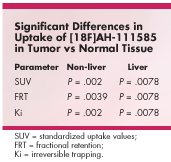Novel PET Tracer Detects Breast Tumors and Mets
Dynamic positron emission tomography (PET) imaging with a novel [18F]-labeled cyclic peptide tracer appears able to detect primary breast tumors and metastatic lesions to a variety of organs.
LOS ANGELESDynamic positron emission tomography (PET) imaging with a novel [18F]-labeled cyclic peptide tracer appears able to detect primary breast tumors and metastatic lesions to a variety of organs. This modality offers potential in the diagnosis of cancer, selection of patients for antiangiogenic therapy, and monitoring of therapy, particularly antiangiogenic or anti-αvβ3/5 therapies, investigators from the United Kingdom reported at the 2007 American Association for Cancer Research annual meeting (abstract LB-5).
The Rationale
Laura M. Kenny, MD, of Imperial College London and Hammersmith Hospitals, London, described the novel approach and its rationale. Tumor angiogenesis is associated with the expression of αvβ3/5 integrin on the tumor neovascular endothelium. The αvβ3/5 integrin potentiates the action of various growth factors and is associated with a more aggressive breast cancer phenotype. It is the therapeutic target for the investigational anti-αvβ3 antibody Vitaxin (MedImmune), which interferes with blood vessel formation by inducing apoptosis in newly generated endothelial cells.
[18F]AH-111585 is a novel [18F]-labeled cyclic peptide that contains an arginine-glycine-aspartic (RGD) motif that binds αvβ3/5 integrin with high nanomolar affinity. The tracer was able to predict early response to angiogenic inhibitors in vivo.
The current phase I/II study evaluated the ability of the tracer to detect tumors in humans. Eight healthy volunteers underwent a total body PET scan, and seven patients with advanced breast cancer underwent PET with a focus on lesions of interest as well as normal tissue. In the cancer patients, PET results were correlated with those of a CT scan. Investigators calculated standardized uptake values (SUVs) (this normalizes tumor uptake to injected activity and body weight or surface area). Pharmacokinetic modeling was used to calculate the fractional retention (FRT) and irreversible trapping (Ki) of [18F]AH-111585 within each lesion.

The technique provided good visualization of the primary tumors and also metastases to the pleura, lymph nodes, and lung. It was safe and well tolerated, with no tracer-related adverse events. Healthy volunteers excreted 57% of the [18F] activity; the organs with the highest mean absorbed dose per unit were the urinary bladder wall, kidney, cardiac wall, spleen, and wall of the upper intestine, Dr. Kenny reported. "Interestingly, we found an incidental meningioma in an asymptomatic healthy volunteer," she said.
In the advanced breast cancer patients, the combination of PET and CT imaged 18 of 19 lesions. Uptake of the tracer was seen throughout the tumor or in the circumference of the lesion. The differences between uptake in tumors vs corresponding normal tissues were highly significant for nonhepatic lesions (see Table), she said. Hepatic metastases had low levels of tracer uptake, compared with surrounding normal tissue.